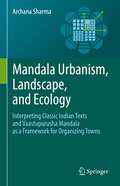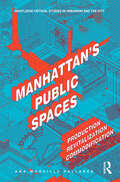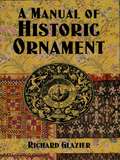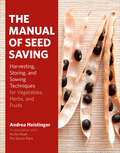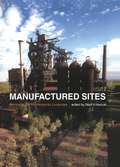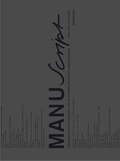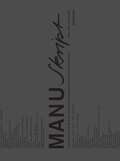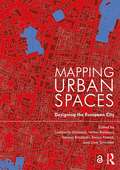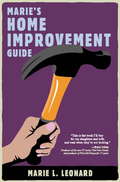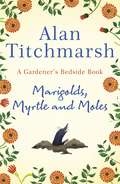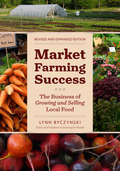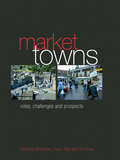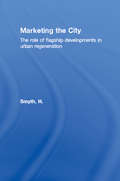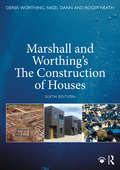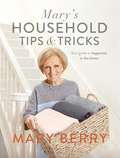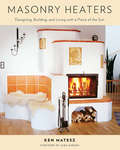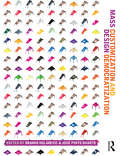- Table View
- List View
Mandala Urbanism, Landscape, and Ecology: Interpreting classic Indian texts and Vaastupurusha mandala as a framework for organizing towns
by Archana SharmaClassic Indian texts and Vaastupurusha Mandala are not often discussed in the western discourse on urbanism, even while much of these predate the commonly taught European writings. This book sheds light on some of those forgotten concepts, thus making the lesser discussed classic Indian town organization ideas accessible to architecture, landscape, and urban planning students worldwide. The resonance of these concepts in present times are reviewed through case studies of select Hindu temple towns in India. Furthermore, the author underscores the formal abstraction of the classic Indian Mandala and transplants the discourse from sociology to socio-ecologically adept trans-disciplinary design thinking. The creative interpretations offer a premise to start revising classic models for current practice to influence the urbanism and ecology of a place in accordance with the changing climate.
Manhattan's Public Spaces: Production, Revitalization, Commodification (Routledge Critical Studies in Urbanism and the City)
by Ana Morcillo PallarésManhattan’s Public Spaces: Production, Revitalization, Commodification analyzes a series of architectural works and their contribution to New York’s public space over the past few decades. By exploring a mix of urban mechanisms, supportive frameworks, legal systems, and planning guidelines for the transformation of the city’s collective realm, the text frames Manhattan as a controversial landscape of interests and concerns to authorities, communities, and, very importantly, developers. The production, revitalization, and commodification of Manhattan’s public spaces, as a phenomenon and as a subject of study, also highlights the vicissitudes of the reconciliation of the many different agents, which are part of the process. The challenge of the book does not only lie in the analysis of good design but, more importantly, in how to understand the functional mechanisms for the current trends in the production of space for public use. A complex framework of actors, governance, and market monopolies, which invites the reader to participate in the debate of how these interventions contribute, or not, to an inclusive environment anchored in the existing built fabric. Manhattan’s Public Spaces invites reflection on the revitalization of the city’s shared space from all dimensions. Beautifully illustrated in black and white, with over 50 images, this book will be of interest to scholars and students in architecture, planning, and urban design.
Manhattan's Public Spaces: Production, Revitalization, Commodification (Routledge Critical Studies in Urbanism and the City)
by Ana Morcillo PallarésManhattan’s Public Spaces: Production, Revitalization, Commodification analyzes a series of architectural works and their contribution to New York’s public space over the past few decades. By exploring a mix of urban mechanisms, supportive frameworks, legal systems, and planning guidelines for the transformation of the city’s collective realm, the text frames Manhattan as a controversial landscape of interests and concerns to authorities, communities, and, very importantly, developers. The production, revitalization, and commodification of Manhattan’s public spaces, as a phenomenon and as a subject of study, also highlights the vicissitudes of the reconciliation of the many different agents, which are part of the process. The challenge of the book does not only lie in the analysis of good design but, more importantly, in how to understand the functional mechanisms for the current trends in the production of space for public use. A complex framework of actors, governance, and market monopolies, which invites the reader to participate in the debate of how these interventions contribute, or not, to an inclusive environment anchored in the existing built fabric. Manhattan’s Public Spaces invites reflection on the revitalization of the city’s shared space from all dimensions. Beautifully illustrated in black and white, with over 50 images, this book will be of interest to scholars and students in architecture, planning, and urban design.
Manual Drafting for Interiors
by Christine CavataioThe interior designer's guide to effective hand drafting The kinesthetic act of completing a manually drafted drawing gives interior designers a greater understanding of the space they're designing, time to reflect on their work, and the skills needed to quickly draw freehand for presentations and design concept developments. Manual Drafting for Interiors is an essential reference for interior designers learning how to manually draft scaled floor plans, elevations, sections, and three-dimensional drawings. Clearly explaining techniques and methods, it begins with an explanation of drafting tools and their various uses, and then presents instructions and illustrations that indicate how to complete increasingly more difficult drafting conventions. Additionally, readers will learn drawing techniques for indicating various materials, symbols for coordinating related drawings, and architectural lettering. Complemented with extensive drawings, inspiring examples, and tips for developing your own style of graphic expression, Manual Drafting for Interiors arms readers with essential skills they'll use throughout their career as a designer.
Manual Drafting for Interiors, Enhanced Edition
by Christine CavataioThe interior designer's guide to effective hand drafting The kinesthetic act of completing a manually drafted drawing gives interior designers a greater understanding of the space they're designing, time to reflect on their work, and the skills needed to quickly draw freehand for presentations and design concept developments. Manual Drafting for Interiors is an essential reference for interior designers learning how to manually draft scaled floor plans, elevations, sections, and three-dimensional drawings. Clearly explaining techniques and methods, it begins with an explanation of drafting tools and their various uses, and then presents instructions and illustrations that indicate how to complete increasingly more difficult drafting conventions. Additionally, readers will learn drawing techniques for indicating various materials, symbols for coordinating related drawings, and architectural lettering. Complemented with extensive drawings, inspiring examples, and tips for developing your own style of graphic expression, Manual Drafting for Interiors arms readers with essential skills they'll use throughout their career as a designer.
A Manual of Historic Ornament
by Richard GlazierExceptionally comprehensive, easy-to-use guide surveys the evolution of historic ornament in architecture and the applied arts — from primitive ornaments of Oceania, Egypt, and Assyria to a Gothic doorway in Amiens, the tomb of Lorenzo de Medici, and a classic early-19th-century sofa by Thomas Hope. Over 700 black-and-white illustrations. 16 plates of photographs.
The Manual of Seed Saving: Harvesting, Storing, and Sowing Techniques for Vegetables, Herbs, and Fruits
by Andrea HeistingerAs small-scale gardens and farms continue to pop up in back yards and on balconies, food growers are embracing the process by planting, preserving, and pickling their produce. Now this guide offers the expertise needed to carry that sensibility even further to practice seed saving.
Manufactured Sites: Rethinking the Post-Industrial Landscape
by Niall Kirkwood**This title was originally published in 2001. The version published in 2011 is a PB reprint of the original HB** Manufactured Sites focuses on the legacy of industrial production and pollutants on the contemporary landscape and their influence on new scientific research, innovative site technologies and progressive site design. It presents innovative environmental, engineering and design approaches along with ongoing research and built projects of international significance. Contributions range from innovative scientific engineering research from industry and federal agencies to contemporary international and regional professional reclamation and redevelopment projects such as the 2000 Olympic Games in Sydney, Australia and the A.G. Thyssen steelworks and blast furnace planning in Germany's Ruhr region.
Manufactured Sites: Rethinking the Post-Industrial Landscape
by Niall Kirkwood**This title was originally published in 2001. The version published in 2011 is a PB reprint of the original HB** Manufactured Sites focuses on the legacy of industrial production and pollutants on the contemporary landscape and their influence on new scientific research, innovative site technologies and progressive site design. It presents innovative environmental, engineering and design approaches along with ongoing research and built projects of international significance. Contributions range from innovative scientific engineering research from industry and federal agencies to contemporary international and regional professional reclamation and redevelopment projects such as the 2000 Olympic Games in Sydney, Australia and the A.G. Thyssen steelworks and blast furnace planning in Germany's Ruhr region.
Manuscript: Essentials for the Everyday Use of Interior Architects and Designers
by Axel Müller-SchöllThis book provides essential introductory information for designers and interior designers. From the realm of interior design, for example, it deals with ceilings, floors, doors, windows, stairs, etc. – from that of material science, with carpets, wallpaper, wall paint, glass, wood materials, stone, and concrete. It also presents architectural drawing: techniques of representation, descriptive geometry, technical drawing, standard dimensions, signs and symbols, and mathematical foundations; attention is also given to the fundamentals of graphic design, preparing documents for publication, file formats, and color systems. All of this is generously leavened with practical examples; original essays by Ruedi Baur, Axel Kufus, Norbert Rademacher, Martin Kunz, and others; and thought-provoking quotations. If they want to, readers may separate the pages of the Japanese binding – this way they get room to add their personal notes and comments.
Manuskript: Essentials für den Alltag von Innenarchitekten und Designern
by Axel Müller-SchöllDas Buch bietet grundlegende erste Informationen für Innenarchitekten und Designer. Aus den Gebieten der Innenraumgestaltung zu Decken, Fußböden, Wänden, Türen, Fenstern, Treppen etc. Aus der Materialkunde: zu Teppichen, Tapeten, Wandanstrichen, Glas, Holzwerkstoffe, Stein, Beton. Ein weiterer Schwerpunkt ist dem Entwerfen und Aufzeichnen gewidmet: Darstellungstechniken, darstellende Geometrie, technische Zeichnungen, Orientierungsmaße, Zeichen und Symbole und mathematische Grundlagen; hinzu kommen grafische Grundbegriffe, Elemente der Druckvorstufe, Dateiformate und Farbsysteme. Ergänzt und veranschaulicht werden die Informationen mit Praxisbeispielen, originalen Textbeiträgen von Ruedi Baur, Axel Kufus, Norbert Rademacher, Martin Kunz u.a. sowie anregenden Zitaten. Falls der Leser, die Nutzerin des Buches wollen, können die Seiten in Japanbindung aufgetrennt werden: es entsteht so immer wieder Raum für persönlichen Ergänzungen und Notizen.
Mapping Urban Spaces: Designing the European City
by Lamberto Amistadi Valter Balducci Tomasz Bradecki Enrico Prandi Uwe SchröderMapping Urban Spaces focuses on medium-sized European cities and more specifically on their open spaces from psychological, sociological, and aesthetic points of view. The chapters illustrate how the characteristics that make life in medium-sized European cities pleasant and sustainable – accessibility, ease of travel, urban sustainability, social inclusiveness – can be traced back to the nature of that space. The chapters develop from a phenomenological study of space to contributions on places and landscapes in the city. Centralities and their meaning are studied, as well as the social space and its complexity. The contributions focus on history and theory as well as concrete research and mapping approaches and the resulting design applications. The case studies come from countries around Europe including Poland, Italy, Greece, Germany, and France, among others. The book will be of interest to students, scholars, and practitioners in architecture, urban planning, and landscape architecture.
Mapping Urban Spaces: Designing the European City
by Lamberto Amistadi Valter Balducci Tomasz Bradecki Enrico Prandi Uwe SchröderMapping Urban Spaces focuses on medium-sized European cities and more specifically on their open spaces from psychological, sociological, and aesthetic points of view. The chapters illustrate how the characteristics that make life in medium-sized European cities pleasant and sustainable – accessibility, ease of travel, urban sustainability, social inclusiveness – can be traced back to the nature of that space. The chapters develop from a phenomenological study of space to contributions on places and landscapes in the city. Centralities and their meaning are studied, as well as the social space and its complexity. The contributions focus on history and theory as well as concrete research and mapping approaches and the resulting design applications. The case studies come from countries around Europe including Poland, Italy, Greece, Germany, and France, among others. The book will be of interest to students, scholars, and practitioners in architecture, urban planning, and landscape architecture.
Marie's Home Improvement Guide
by Marie L. LeonardTired of paying the painter to create a mess on your floors? Can’t be held up another day waiting for a plumber between 9 and 5? Feeling threatened by the growing pile of fix-it projects in your basement? Marie’s Home Improvement Guide offers all the tips you need to tackle these projects ... yourself! Marie L. Leonard, owner of her own home improvement business, has been teaching home repair to women for years. With the belief that women shouldn’t have to depend on others for home repair, Leonard is helping thousands of women save money and time, conquering the fear of do-it-yourself work. Marie’s Home Improvement Guide provides readers with the know-how to tackle projects around the house. Leonard covers the basics: introduction to tools, safety precautions, necessary prep-work, and shopping for the right materials. Leonard’s tips are written in an informative and accessible manner, paired with detailed illustrations. A reassuring source of encouragement, Marie’s Home Improvement Guide is a must-have book for all first-time do-it-yourselfers.
Marigolds, Myrtle and Moles: A Gardener's Bedside Book
by Alan TitchmarshThe perfect bedside book for the green-fingered - hilarious and touching poems on a gardening theme written and introduced by the nation's favourite gardener and presenter of ITV's Love Your Garden, Channel 5's Secrets of the National Trust and with his own show on Classic FM.From touching poems on the peony, the snowdrop and the sweet pea to hilarious verse on Emily the Gardener and the Garden Design Course, this is Alan Titchmarsh's heartfelt and entertaining celebration of his favourite space - the garden.
Market Farming Success: The Business of Growing and Selling Local Food, 2nd Editon
by Lynn ByczynskiAn insider's guide to market gardening and farming for those in the business of growing and selling food, flowers, herbs, or plants. Market Farming Success identifies the key areas that usually trip up beginners—and shows how to avoid those obstacles. This book will help the aspiring or beginning farmer advance quickly and confidently through the inevitable learning curve of starting a new business. Written by the editor of Growing for Market, a respected trade journal for market farmers, Market Farming Success condenses decades of growing experience from every part of the United States and Canada. It focuses on the factors that are common to market gardeners everywhere and offers professional advice that includes: • How much you'll need to spend to start a market farming business; • How much you can expect to earn; • Which crops bring in the most money—and whether you should grow them; • The essential tools and equipment you will need; • The best places to sell your products; • How to keep records to maximize profits and minimize taxes; • Tricks of the trade that will make you more efficient in the greenhouse, field, and market. This new Chelsea Green edition of a 2006 classic is greatly updated and expanded, and includes full-color photos, charts, and graphs, plus many inspiring and instructive profiles of successful market-farming pioneers.
Market Towns: Roles, challenges and prospects
by Neil PoweOriginal and insightful, this volume, giving in-depth consideration to the key issues affecting the future of market towns, provides readers with a framework for evaluating policy initiatives and progress in market towns.Through a detailed analysis of the characteristics of over 200 towns and in-depth studies of eleven towns in different parts of E
Market Towns: Roles, challenges and prospects
by Neil PoweOriginal and insightful, this volume, giving in-depth consideration to the key issues affecting the future of market towns, provides readers with a framework for evaluating policy initiatives and progress in market towns.Through a detailed analysis of the characteristics of over 200 towns and in-depth studies of eleven towns in different parts of E
Marketing the City: The role of flagship developments in urban regeneration
by H. SmythThis book assesses the value of flagship developments and draws out lessons for best policy and practice. It looks at marketing strategies and the sales process for flagship developments and the areas in which they are located for urban regeneration. It discusses the management of marketing strategies and the development through the policy formulation, project implementation and policy/project evaluation. The author examines the strategies to date of 'marketing the city' and the conceptual scope and limits for developing the concept. He also looks at the extent to which people can be integrated into the urban 'product' and the advantages and disadvantages of this. Finally the impact of all these issues is assessed for the policy makers, planners, developers, architects and city authorities.
Marketing the City: The role of flagship developments in urban regeneration
by H. SmythThis book assesses the value of flagship developments and draws out lessons for best policy and practice. It looks at marketing strategies and the sales process for flagship developments and the areas in which they are located for urban regeneration. It discusses the management of marketing strategies and the development through the policy formulation, project implementation and policy/project evaluation. The author examines the strategies to date of 'marketing the city' and the conceptual scope and limits for developing the concept. He also looks at the extent to which people can be integrated into the urban 'product' and the advantages and disadvantages of this. Finally the impact of all these issues is assessed for the policy makers, planners, developers, architects and city authorities.
Marshall and Worthing's The Construction of Houses
by Duncan Marshall Derek Worthing Nigel Dann Roger HeathThe sixth edition of The Construction of Houses builds on the success of the previous five editions. The book provides a comprehensive introduction to the principles and processes of the construction of houses and their services. As such it is aimed at providing a broad understanding of domestic building construction for students as part of their academic studies and as a useful information source for practitioners. The existing chapters have all been updated and most of them expanded to take account of changes to dwelling house construction since the last edition and there are new chapters on ‘Modern Methods of Construction’ and ‘Regulatory controls and building standards’. Additionally, many new and/or updated photographs and diagrams have been added. As with the previous editions, the authors have concentrated on presenting current mainstream approaches to the construction of houses. The detailed, yet accessible, text that is supported by hundreds of coloured photographs and diagrams provides clear explanations of the many complex processes that go into the building of a house. A deeper insight into modern construction is also given by the book’s consideration of historical building techniques from the 18th century onwards in order to illustrate how and why we build houses in the way we do now.
Marshall and Worthing's The Construction of Houses
by Duncan Marshall Derek Worthing Nigel Dann Roger HeathThe sixth edition of The Construction of Houses builds on the success of the previous five editions. The book provides a comprehensive introduction to the principles and processes of the construction of houses and their services. As such it is aimed at providing a broad understanding of domestic building construction for students as part of their academic studies and as a useful information source for practitioners. The existing chapters have all been updated and most of them expanded to take account of changes to dwelling house construction since the last edition and there are new chapters on ‘Modern Methods of Construction’ and ‘Regulatory controls and building standards’. Additionally, many new and/or updated photographs and diagrams have been added. As with the previous editions, the authors have concentrated on presenting current mainstream approaches to the construction of houses. The detailed, yet accessible, text that is supported by hundreds of coloured photographs and diagrams provides clear explanations of the many complex processes that go into the building of a house. A deeper insight into modern construction is also given by the book’s consideration of historical building techniques from the 18th century onwards in order to illustrate how and why we build houses in the way we do now.
Mary's Household Tips and Tricks: Your Guide to Happiness in the Home
by Mary BerryOne of the Guardian's TOP TEN BOOKS to gift. 'It's practical AND beautiful . . . an ideal gift' Graham Norton, BBC Radio 2Britain's best-loved cook and national treasure Mary Berry lets readers in on her very own household secrets . . . A comprehensive, beautifully illustrated guide that shares her greatest tips on how to care for your home. 'This book is a collection of skills I've learned for running a home. Gleaned from years of practical experience, along with all the hints that friends and family have imparted to me, I hope it will be a helping hand' - Mary BerryInside you'll find . . . A KITCHEN KNOW-HOW for the heart of your home - Freezer tips - Organize your food - CLEANING & CONFIGURING YOUR HOME - Create cleaning products from store cupboard items - LAUNDRY & WARDROBE WISDOM - Banish moths from your home for good - Remove stains from every kind of fabric - get green fingered with GARDENING & FLOWERS - Bring greenery into your home even without a garden - Create beautiful flower arrangements - And finally master the art of HOSTING & ADDING THE EXTRA TOUCHES for sparkling parties at home.Easy to use, practical and gorgeously illustrated, Mary's Household Tips & Tricks covers everything from Mary's golden rules for baking to her favourite flowers for each season, from how to polish silver to whether tea should be poured before or after milk. With secrets for accomplishing the most challenging home-keeping tasks with ease, Mary's wonderfully simple book will help turn any house into a home.'The Queen of British baking has whipped up a recipe for home happiness' The Independent'A domestic goddess' The Daily Telegraph
Masonry Heaters: Designing, Building, and Living with a Piece of the Sun
by Ken Matesz Albie BardenMasonry Heaters is a complete guide to designing and living with one of the oldest, and yet one of the newest, heating devices. A masonry heater’s design, placement in the home, and luxurious radiant heat redefine the hearth for the modern era, turning it into a piece of the sun right inside the home. Like the feeling one gets from the sun on a spring day, the environment around a masonry heater feels fresh. The radiant heat feels better on the skin. It warms the home both gently and efficiently. In fact, the value of a masonry heater lies in its durability, quality, serviceability, dependability, and health-supporting features. And it is an investment in self-sufficiency and freedom from fossil fuels. The book discusses different masonry heater designs, including variations extant in Europe, and explains the growth of their popularity in the United States beginning in the late 1970s. For the reader who may be familiar only with open fireplaces and metal woodstoves, Masonry Heaters will bring a new understanding and appreciation of massive heat storage and gentle-but-persistent radiant heat. Masonry heaters offer a unique comfort that is superior to that from convection heat from forced-air systems, and more personal than that offered by “radiant” floors. As Matesz demonstrates, the heat from the sun or from a masonry heater is genuine heat instead of just insulation against the loss of heat. Those who are looking to build, add onto, or remodel a house will find comprehensive and practical advice for designing and installing a masonry heater, including detailed discussion of materials, code considerations, and many photos and illustrations. While this is not a do-it-yourself guide for building a masonry heater, it provides facts every heater builder should know. Professional contractors will find this a useful tool to consult, and homeowners considering a new method of home heating will find all they need to know about masonry heaters within these pages.
Mass Customization and Design Democratization
by Branko Kolarevic José Pinto DuarteParametric design and digital fabrication are enabling non-designers to mass produce non-standard, highly differentiated products – from shoes and tableware to furniture and even houses. The result of these newly available mass customization tools has been a ‘democratization’ of design. Mass Customization and Design Democratization is the first book to address this recent phenomenon. Demonstrating how the considerable potential of these tools can be realized in practice, it introduces essential technologies and design approaches and provides numerous examples of the latest, cutting edge work from leading design firms, manufacturers and thinkers. The book examines what mass customization means for architecture and the building industry and investigates its impact on the sector’s most commoditized enterprise – suburban housing. Asking whether design democratization is viable in the current context and exploring what kind of mass customization is possible, useful, and desirable, it poses fundamental questions about the authorship of design and the functional and aesthetic quality of products designed by non-designers. A highly designed book featuring over 200 color illustrations, this is essential reading for professionals as well as students taking courses in digital architecture, parametric design, and mass customization.
